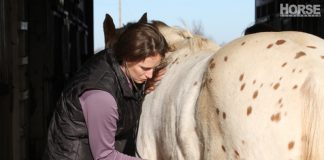When veterinarians evaluate horses for lameness, they usually provide the owners with written descriptions of what they observe. For example, “Lame at trot, left fore, +3 … ,” is what you might find scrawled in a vet’s notes. While “lame at the trot” is pretty clear-cut, what does the “+3” mean?
Here are the definitions the American Association of Equine Practitioners assigns to each of the numbers within the lameness grading system:
0 – Lameness not perceptible under any circumstances.
1 – Lameness is difficult to observe and is not consistently apparent, regardless of circumstances (e.g., weight carrying, circling, inclines, hard surface, et cetera).
2 – Lameness is difficult to observe at a walk or when trotting in a straight line but consistently apparent under certain circumstances (e.g., weight carrying, circling, inclines, hard surface, et cetera).
3 – Lameness is consistently observable at a trot under all circumstances.
4 – Lameness is obvious at a walk.
5 – Lameness produces minimal weightbearing in motion and/or at rest or a complete inability to move.






This was helpful, thanks!!
never knew that!
helpful
Sometimes I can feel a “gimp” when riding, but usually over rough ground or rocks….like when I walk barefooted over gravel.